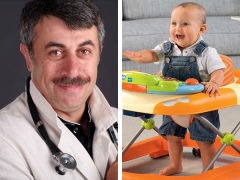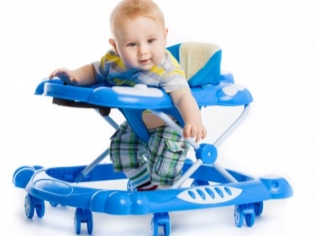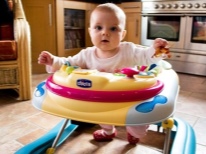Dr. Komarovsky about the walker: all the pros and cons
Walkers for kids in our country are considered something important, and in the list of acquisitions for a child they often stand next to a cot, a stroller and a bath for bathing. They are considered a good and practical gift for a newborn and his parents. But are they really important - a question that from time to time arises in the heads of all parents.
Another topic that worries moms is whether the walkers will harm the child’s development. These questions are answered by a recognized by millions of parents a pediatric doctor and the author of numerous books and articles about the health of kids Evgeny Komarovsky.
What it is?
In the definition of Wikipedia, a walker is an aid for the disabled and the elderly. Their main task is to help a person maintain an upright posture and balance when walking. The first patented devices for adults appeared in the mid-1940s.
The story of the emergence of children's walkers is more youthful, and most experts are inclined to believe that this was a good marketing move. The first such products, which were positioned as children’s, appeared in England in 1953. And devices for kids on wheels, almost as we see them now, were designed in the USA in 1970.
In Russia, walkers in stores began selling only about 20 years ago. The fact is that during Soviet times, pediatric standards did not imply the use of such devices: doctors considered them harmful for the development of the child, and therefore there was a ban on the production and sale of baby walkers in the country. Now, many experts are returning to those standards and argue that these bans were more than reasonable and correct.
However, the walker entered our lives, and now parents need to carefully weigh all the advantages and disadvantages of this invention in order to understand whether it is necessary to buy them for their own child.
Helping adults, who previously knew how to move on two legs, but because of illness or injury have lost such an opportunity to walk, is quite natural, say doctors. But the use of baby walkers for kids who have not yet made a single independent step in this life, raises many questions, contradictions and disputes.
"Pros and cons"
Walkers Evgeny Komarovsky considers a device that has a very beneficial effect on parents, and not on the baby. They were created, first of all, in order to make life much easier for the mother. After all, it is very convenient - she put the baby in a walker and went to cook, wash, iron, watch TV or work at the computer. The kid will not go anywhere from them, will not fall, will not stumble on a sharp corner.
However, quite often parents complain that the child has managed to fall out of the walker. This does not happen by itself, but mainly if mom did not take security measures. Attachment on wheels can tip over when colliding with steps, with solid large single objects that may fall into the wheel, as well as if the child is poorly secured in the walker.
Modern walkers have bright colors, almost all models are equipped with a play area with fixed toys, there are musical walkers.
Because the child, by and large, is not against such a pastime, because in the walker it is more interesting to him than in the crib.Supporters and fans of devices claim that they carry the most important developmental function. This statement cannot be considered true, since there is at least some proven benefit from staying a baby in a frame on wheels. Can't walker sellers prove their beneficial effects, no matter how hard they try.
But there are well-founded opinions of doctors, who argue that the walker is not only harmful to the child, but also dangerous. Yevgeny Komarovsky argues that the decision whether to use a walker should be made only by parents, and no one else. He does not believe that the hour spent in the walker is dangerous to the health of the crumbs, but a few - already an alarming signal. In all, a measure is needed, but in relation to verticalizing devices, which include walkers, this statement is doubly true.
What is the danger?
Nature disposed of in such a way that the child in its development went through several stages, which clearly confirms the main stages of evolution. First, the baby lies, then develops coups, then begins to try to crawl, sit, and only after that - walk. Such a sequence is important for further normal development. The spine is not sufficiently strong and does not allow the child to sit on their own, and the weak muscles of the back, abdomen, and lateral muscles do not allow the crumbs to creep confidently and stand up.
The child must go through all the stages independently, says Yevgeny Komarovsky. He will sit down when his back is ready for this, and he will go when his spine and muscular skeleton get stronger. If parents start to force events, force the child to sit down and stand before the allotted time, then the vertical load on the spine weak from birth will increase many times. This is fraught with not only a violation of posture in the future, but also more serious consequences that can even lead to disability.
Early verticalization is the right way to diseases of the spine and the musculoskeletal system.
From this point of view, the use of a walker poses a certain danger to children, who still do not know how to sit and crawl on their own. Komarovsky strongly does not recommend the use of such devices for children under the age of 9 months in general.
Further, depending on the skills and development of the child, the walker can be used for half an hour - forty minutes a day. But the baby should not be in them all the time while he is awake, because the crumb is not yet able to understand his feelings and inform the parents that he has a tired back. And the damage of the vertical load is also relevant for children aged 10 months, and even per year.
We recommend reading about this in more detail in the article “For how many months can a baby be put on a walker and is it worth it»
How to choose?
Choosing a walker is as simple as it may seem at first glance. After all, the range of such goods in all children's stores is quite large. For a child who has already learned how to get up with support, but who still does not know how to take the first steps, you can buy walkers on wheels. The main thing in them is a reliable foundation. Make sure that it is wide enough, made of strong plastic, and the wheels themselves are securely attached, but at the same time they rotate easily.
The seat should be comfortable, the back - soft. It is best to buy a walker, the design of which provides the ability to adjust the depth of landing.
For children who have already learned how to take the first steps, but so far are very shaky and uncertain, you can choose walkers-pushers. When choosing them, you need to pay attention to the fact that the height was adjusted or was initially optimal for your baby, so that the crumb did not hump or reach for handrails upwards.
The material from which the verticalization device is made must be strong, eco-friendly (after all, kids will definitely try it on taste, on tooth). Walkers must be resilient.It is desirable that they were equipped with a development table so that the crumbs were interesting.
Before choosing, it is best to get acquainted with reviews of certain models that are made by other parents.
How to use?
If parents are already aware of the age and length of their stay in the walker, you should definitely check your knowledge of how to operate the device. Do not force the child to plant, if he strongly resists this, does not want or is afraid of walkers. You can not leave a child alone in a walker without supervision. Optimally, if the mother will do household chores in the same room where the child will move in the walker.
Such devices should not be used for children with diseases of the musculoskeletal system - it is very harmful. Also, walkers are contraindicated in boys and girls, whom the doctor previously reasonably (based on x-ray) diagnosed “rickets”. You should not try to plant in them a child with severe neurological disorders, such as cerebral palsy, for example.
Even if a perfectly healthy baby grows in your family, you should always consult a pediatrician before using walkers.
If the doctor does not see any contraindications, you can put the child in compliance with safety rules and, of course, with the mind.
Tips of Dr. Komarovsky
Summarizing all the above, one can single out the main recommendations that pediatrician Yevgeny Komarovsky gives in his programs and publications.
If you were given a walker for a child, you should take them away until 9 months. Until this age, it is best to encourage the child to crawl, since it is this method of movement that allows the children's spine and muscles to get stronger quickly.
Claims that the walker will teach to walk and strengthen the muscles - no more than a myth. On the contrary, the walkers deprive the child of a sense of balance, create the illusion of a safe space. Children who spent a lot of time in walkers usually start walking on their own after their peers. They are afraid, because they have not learned to group and fall safely in a walker. And muscles strengthen only crawling, gymnastics and independent attempts to stand and walk, and not holding devices.
When placing a child in a walker, you should limit his movements so that the child does not fall down from the ladder, turn over and get injured.
The maximum time spent in a walker should not exceed 1 hour. The average “harmless” stay in the supporting device is 15 minutes.
It is harmful to be long in a walker with a seat to children, who rely not on a full foot, but on socks. This can lead to problems with the development of the hip joint, may contribute to problems with the foot. So kiddies much more useful than the usual crawling around the house.
Learn more about how to choose the right and safe walker, you will learn from the following video.






























